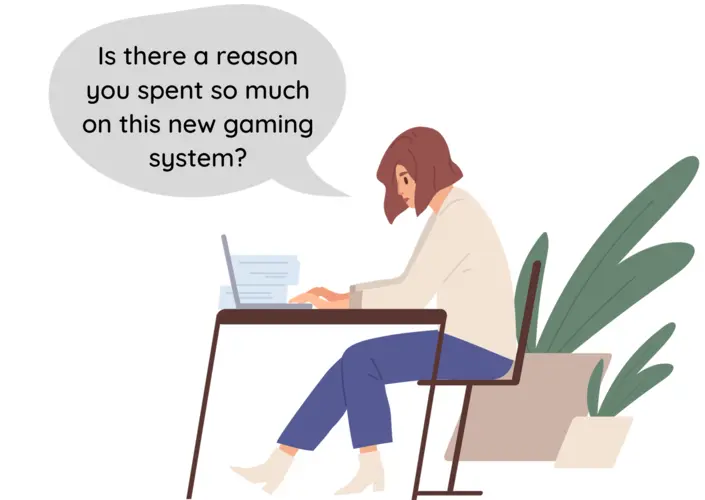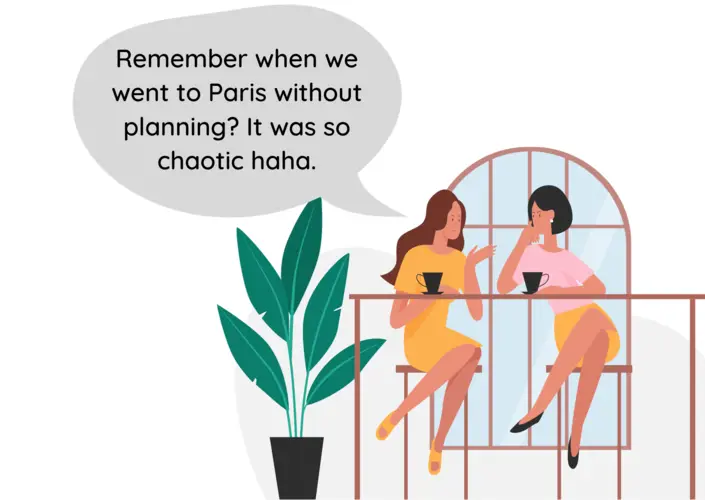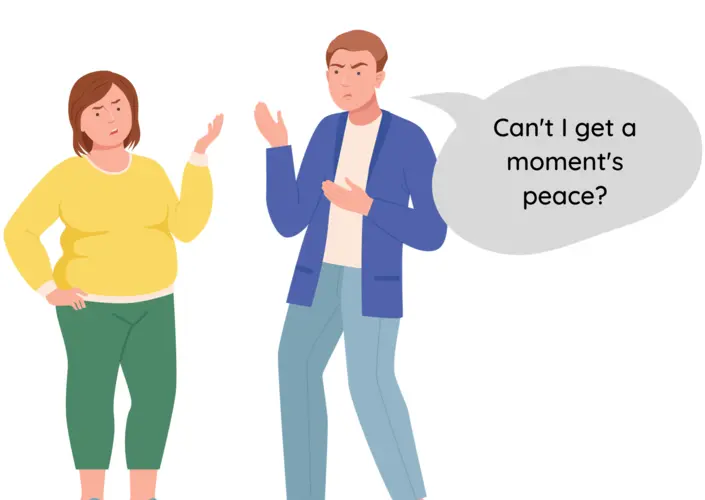The term “narcissistic rage” refers to a reaction that emerges when someone with narcissistic tendencies perceives a threat to their self-esteem or self-worth.
It can manifest anywhere from cold, passive-aggressive retaliation to explosive anger.
In this article, I will guide you through six examples of narcissistic rage to help you understand exactly what this bizarre behavior looks like.
Suggested Reading: What Is Narcissistic Rage? (A Complete Guide)
1.) Smashing Objects
Jill and Mike are sitting together in their living room.
They start looking through their monthly expenses.
The atmosphere is neutral until Jill spots a higher-than-usual charge on her card.
After looking into it further, Jill asks Mike:
“Is there a reason you spent so much on this new gaming system?”

In this situation, Jill wants to understand the unexpected expense.
However, narcissists often struggle with criticism, even when it is not intended.
For Mike, Jill’s question isn’t just about the gaming system. In his mind, it becomes an accusation, a challenge to his decision-making.
Feeling attacked and needing to regain a sense of control and superiority, Mike’s response is disproportionate to Jill’s simple query.
His emotional response, fueled by perceived criticism, overrides logical thought.
Instead of answering the question or discussing the expense, he redirects his anger and frustration onto a vase.
He grabs the vase and hurls it against the wall.
This act isn’t just about releasing anger; it’s a demonstration of power, a way to shift the focus from the initial “accusation” and to intimidate or silence Jill.
Jill, taken aback by the sudden display of aggression, will now feel nervous about addressing similar topics in the future.
This cycle, if repeated, can suppress open communication and create an environment of fear or tension in relationships with individuals exhibiting narcissistic rage.
2.) Silent Treatment
Clara and Zoe, close friends for many years, are sitting together sipping tea, lost in memories of their past adventures.
As they laugh and chat, Clara recalls one particularly unplanned trip:
“Remember when we went to Paris without planning? It was so chaotic haha.”

In Clara’s eyes, she’s simply highlighting a shared memory.
However, to Zoe, the comment isn’t a trip down memory lane.
As mentioned in the previous section, narcissists are sensitive to perceived criticism or any hint of blame, even when unintended.
So, instead of hearing Clara’s words as a lighthearted reflection, Zoe perceives it as a pointed jab at her organizational skills.
She believes Clara is blaming her for the unplanned nature of the trip and, consequently, the resulting chaos.
Rather than voicing her feelings or seeking clarification, Zoe retreats into herself, building an icy wall between them.
This act of going cold and giving the silent treatment is a classic example of narcissistic rage.
It’s a way for Zoe to protect her fragile ego and gain control over the situation.
By refusing to engage, Zoe punishes Clara, making her feel guilty or anxious for her “transgression.”
Suggested Reading: How to Respond to a Narcissist’s Silent Treatment (3 Methods)
3.) Physical Intimidation
At a family BBQ, cousins Jake and Ben discuss what they’ve been up to lately.
The sun is shining, kids are playing in the background, and everyone’s in a good mood.
Ben, wanting to share his recent achievements, says, “I’ve been enjoying my chess club. I just won the club championship. You should join and learn how to play!”

In Ben’s mind, he’s just talking about something he’s proud of and suggesting a way for Jake to get more involved.
But Jake hears it differently.
To him, it sounds like Ben is saying he doesn’t know how to play chess properly.
Jake feels that Ben is hinting that he’s not good enough or smart enough.
This makes Jake feel hurt and embarrassed.
Without thinking, Jake reacts. He pushes Ben and gets in his face, looking very angry.
Everyone at the BBQ stops and stares, shocked at what’s happening. Instead of talking or explaining why he’s upset, Jake leaves, heading straight into the house.
Jake’s sudden aggression is a textbook display of narcissistic rage.
He uses physical intimidation as a shield to protect his bruised ego and to dominate the situation.
By confronting Ben so aggressively, Jake tries to put Ben in his place, making him feel responsible and regretful for his unintended slight.
4.) Playing the Victim:
Brian and Alicia are at home, discussing who does what around the house.
Like many families, chores are a shared responsibility. They’ve split up tasks, but sometimes, it doesn’t feel even.
Trying to communicate her feelings, Alicia says, “Brian, I’ve been handling the dishes each evening. I thought you said you would do them. Could you help out tonight?”
Alicia isn’t trying to accuse Brian of being lazy. She’s just asking for some help, hoping to share the load.
But Brian takes it another way.
Instead of hearing Alicia’s simple request, he feels attacked.
In his mind, she’s not just talking about dishes.
She’s questioning his contribution to the household. Instead of acknowledging her feelings or discussing the dishes, Brian focuses on himself by saying:
“Every day, I’m drowning in stress and endless demands at work,” Brian begins, hoping to draw sympathy. “I come home hoping for a break and some understanding, but it feels like I’m just underappreciated everywhere. Can’t I get a moment’s peace?”

While it’s far more subtle than smashing objects or physical intimidation, Brian’s response is a typical manifestation of narcissistic rage.
Instead of lashing out aggressively, he turns inward, playing the victim to deflect responsibility.
This is his defense mechanism to shield his fragile ego from perceived criticism.
By turning the tables and making himself the victim, he’s trying to control the narrative and make Alicia feel guilty for bringing up her concerns.
Through this tactic, Brian seeks to avoid the chore and make Alicia think twice before raising similar issues in the future.
5.) Road Rage
Sarah is driving on a busy road and trying to change lanes.
Without realizing it, she moves too close to another car, accidentally cutting them off.
Immediately noticing her mistake, Sarah waves her hand, trying to tell the other driver she’s sorry. It wasn’t on purpose, just a simple mistake.
But the other driver, Alex, doesn’t see it that way.
To him, Sarah didn’t just make an error in judgment. In his eyes, she disrespected him, challenging his space on the road.
Narcissists like Alex often view small mistakes made by others as personal attacks.
Instead of accepting Sarah’s apology or simply moving on, Alex reacts with extreme anger.
He pushes down on the gas, driving his car really close to Sarah’s, trying to intimidate her.
Flashing his lights and honking his horn loudly, he’s making a big scene on the road.
Then, with a quick and aggressive move, he speeds around her, shouting and making angry faces and hand gestures.
Alex’s over-the-top reaction is a clear display of narcissistic rage. He feels the need to “punish” Sarah for her mistake, even if she didn’t mean any harm.
By acting aggressive and dangerous on the road, he’s trying to show his dominance, ensuring Sarah and others know not to cross him.
His extreme behavior isn’t just about the driving mistake. It’s about protecting his pride and showing everyone he’s in control.
6.) Withholding Affection
Ella and Ryan are curled up on the couch, watching a romantic movie.
The screen is filled with scenes of couples holding hands and sharing tender moments.
Inspired by the movie, Ella thinks back to their early days of dating.
She softly says, “This reminds me of our early days. I miss how close we used to be.”
In her mind, she’s just sharing a sweet memory, hoping it might spark a loving conversation between them.
But Ryan takes it differently.
He feels Ella is criticizing him, suggesting he’s lost his touch or isn’t romantic anymore.
Feeling attacked, he gets defensive and asks, “So now I’m not good enough?”

From that point on, Ryan changes his behavior.
When Ella tries to get close, like reaching for a hug or going in for a kiss, he moves away on purpose.
Instead of talking about his feelings or trying to understand hers, he avoids affection entirely.
Ryan’s behavior is a prime example of narcissistic rage but in a quieter, more passive-aggressive way.
He’s withholding affection as a form of punishment.
He’s showing Ella that her words have consequences and trying to make her regret saying anything.
It’s not about what she said but about his need to protect his ego and feel in control.
By pulling away from Ella, he’s attempting to make her feel unwanted because he feels insecure about a simple, loving comment.
Suggested Reading: Why Do Narcissists Avoid Intimacy? (4 Reasons)
What Should You Take Away from This Article?
So there you have it, six examples of narcissistic rage. I hope this article brought you value. Thank you so much for taking the time to read it.
About the Author

Hey, I’m Elijah.
I experienced narcissistic abuse for three years.
I create these articles to help you understand and validate your experiences.
Thank you for reading, and remember, healing is possible even when it feels impossible.
